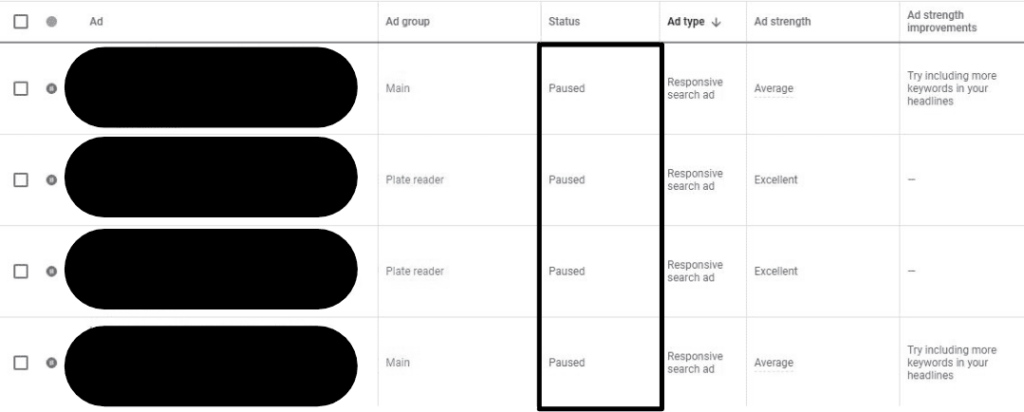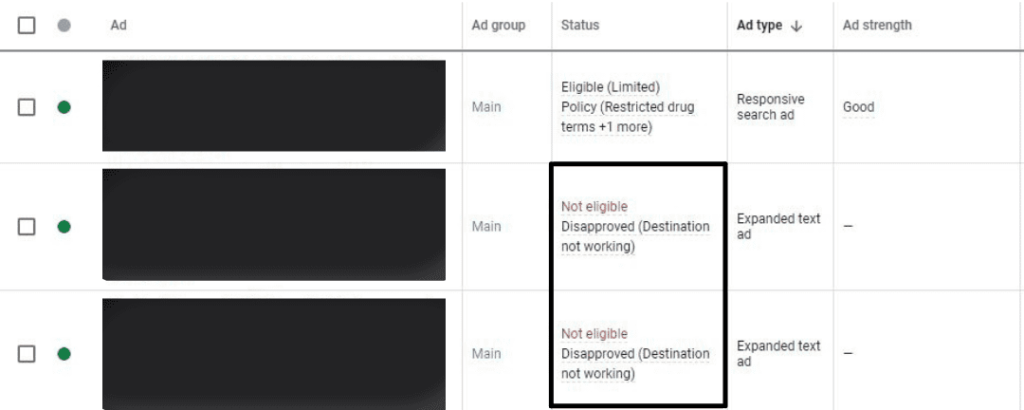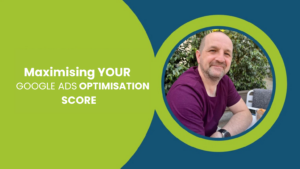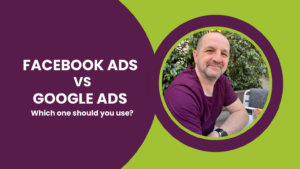Google Ads can be fickle, and sometimes it might seem like your ads have disappeared from the search results entirely. For any advertiser or business owner, whether it is a coffee shop, bakery or fashion brand, this can cause panic. But there’s always a logical explanation as to why your Google Ads disappeared. What’s more, there are also plenty of ways to fix them, from issues related to your account setup to other problems such as optimisation.
Has your ad actually disappeared?
Before you start trying to work out why your ads have disappeared, it’s first of all important to be sure that they’re not showing. Typing in your keywords on Google to see if your ads are showing is not a reliable measure of whether or not they’ve vanished.
Instead, you should look at the data on the Google Ads dashboard – have your ads received any impressions at all or perhaps there has been a drop-off? Has your impression share changed? How many clicks are you getting? If you’re getting impressions and/or clicks, your ads haven’t completely disappeared, you just need to work out if there has been a drop or slow start in performance, and why.
Your Personal Google Ads Video Audit
We'll record a personal audit of your Google Ads account, and explain
- where you're wasting budget
- the opportunities you're missing
- how to improve performance
Get Your Personal Google Ads Audit Now
Get Your Personal Google Ads Audit Video
Please provide your details below and one of our specialists will be in touch as soon as possible.
If your ads have actually disappeared you will likely have received no impressions or clicks over a reasonable period. There are a variety of factors that might have caused this, from issues to do with the performance of the ads, to problems with the quality of your ads, landing pages and ad groups. But don’t worry, there are solutions to ensure your ads start showing again.
Account setup and non-performance issues
Ad removed or paused
Removing or pausing your ads typically requires manual action. Even if you have an automated rule to pause or remove a campaign, ad group or advert, this is typically authorised and set up manually. However, if you simply remove or pause ads in the dashboard, you aren’t always notified if it happens. You can set up email notifications that alert you if any campaigns, ad groups and ads have been removed or paused. This can be particularly helpful if you’re working in a large team.
Removing or pausing ads stops them from showing and should be one of the first things you check if you’re worried your Google Ads have disappeared – you might have paused them by accident, or forgotten to enable them after the initial set up. If they have been paused, enabling them again is as simple as flicking on a switch. However, if they have been removed, you will have to recreate the campaign, ad groups and ads from scratch.
Keep in mind that if you pause your campaigns or ad groups and then re-enable them, they will enter a steep machine learning period which can cause volatile data. So try not to make large changes during the first few weeks to ensure Google has completed this learning phase.


Ad disapproved
If your ads have been disapproved, you will receive a notification in the Google Ads dashboard. Ads are generally disapproved because Google believes that they violate a policy. While writing your ads and organising your ad groups, you should familiarise yourself with Google’s policies to avoid this as disapproved ads aren’t shown at all.

Payment problems
If Google can’t take its payment, your ads won’t show up in the search results. However, if you do have payment issues, you’ll get a notification in the Google Ads dashboard. You can also set up your Google Ads account to send you emails if there are payment issues, and you can manually check by going to the Billing section under Tools & Settings.
Bids too high or low
It’s key to find the sweet spot with your keyword bidding. You need to bid enough to remain competitive, but not too much that you blow your budget too quickly. If you believe your Google Ads disappeared, review your current keyword bids.
Popular Google Ads Videos
If you have recently raised your bids without increasing your budget, this could lead to your budget being spent quicker, and result in your ads not showing as often. Equally, if you are bidding too little, you may not be as competitive to win the Google Ads auctions. It’s worth noting that your monetary bid and quality score of your ads both affect your ad’s position and whether it shows. You should also check whether you have set the maximum cost per click (CPC) of any keywords to exceed your campaign’s budget, as this could also cause your ads not to show.
Search volume too low
Your ads won’t appear at all if the keywords you’re bidding on have too low a search volume. This is why it is crucial to undertake thorough keyword research in the initial set-up stages to identify keywords with good levels of search traffic. Having said this, keyword search volumes can fluctuate due to seasons and events so if/when they get enough traffic, Google may start showing your ads. Bear in mind that if your ads aren’t showing for particular keywords due to low search volume, neither are your competitors.
Remember that as search volumes can rise with market changes, they can also drop. Keywords can shift in search volume, for example, if there is a big drop in the market, and this can also cause your ads to disappear. While this is less likely, and it’s more probable that average searches would start low and then increase or fluctuate, it’s worth consulting a tool such as Google Trends to double-check if there have been any down or upturns in your market that could explain search volume changes.

Mistake in scheduling or targeting
While mistakes in scheduling and targeting might not make your ads disappear entirely, it is likely that they won’t be seen by people who you want to reach. If you think your ads aren’t showing, double-check your targeting and scheduling to ensure it is set up correctly.
As a general rule, you don’t want too tight a schedule on your ads, and if you must, it’s worth setting reasonable days and times. Google will give you information about your scheduling in the Recommendations tab of the dashboard and make suggestions about how you can open up your scheduling to capture the most traffic.
Typically, unless your business is a physical store with opening hours or you have some other need to have specific scheduling, keeping your ads running 24/7 is worth it. You only pay when people click on the ad, after all.
Ad hasn’t been approved yet
Approval of ads doesn’t take long – usually around 10-15 minutes. However, if your ad has been set live and was then disapproved for breaking a policy, you’ll need to have it reapproved before it can go live again.
Optimisation and performance issues
Quality score issues
Your quality score is vital to your visibility. If your quality score isn’t high, you’ll pay more per click and your ad will not rank as highly. You can increase your quality score by keeping relevant keywords grouped together in ad groups, edit landing pages to reference keywords throughout and customise your ad copy for those keywords.
Ad group not focused
While it may not cause your Google Ads to disappear entirely, you may find that if you’re operating on a limited budget with ad groups full of general and unrelated keywords you may encounter issues with your ads being shown. This is because ad groups that aren’t focused will typically have a lower quality score. Operating with a low-quality score means that your CPC is higher. Having a higher CPC will use your budget much quicker and could result in your ads not showing. So, having a strong ad group structure and ads is crucial.
Recent Google Ads Blog Posts
If you think you may be missing out due to poor ad group performance, have a thorough review of your existing ad groups and the keywords in each. It is good practice to use ad groups to group similar keywords together. For example, an eCommerce store running a Google search campaign selling dresses may create ad groups for each style dress on sale (frilly, a-line, maxi etc.). Once you have done this, you can then tailor more specific ads to meet the needs of your potential customer and achieve a higher quality score.
Ad rank not high
Your ad rank is influenced by your ad strength and relevance, the expected click-through rate (CTR) and the landing page experience. All of these should be as strong as possible as if even one of them is low and underperforms, it can affect the whole ad, reducing its impressions and impression share as well as affecting the ad’s position.
You’ll need to optimise your ad copy by including keywords throughout and ensuring that the ad is relevant to the search query. You’ll also need to ensure that your landing page has an awesome user experience, as well as keywords throughout for better relevance – you can also use strong calls to action (CTAs) to encourage conversions. To get a great CTR, you should write ads that will appeal to your audience. You should also make them relevant and fit where the user is in their journey to conversion.
Negative keyword issues
Sometimes, negative keywords can cancel out your active keywords, which would prevent your ads from showing. For example, if you set a campaign-level broad match negative keyword as ‘free CRM’ this would override an active keyword such as ‘CRM free trial’. In this example, making the negative keyword ‘free CRM’ an exact match will help avoid this issue, ensuring the ad shows to the right people.
Fortunately, the Recommendations tab will tell you about conflicting negative keywords which are stopping your ads from matching certain search queries. However, it’s not 100% accurate so you should always check to make sure there aren’t any issues with negative keywords causing your ads to disappear.
Negative bid adjustment issues
While being able to decrease your bid if circumstances change with negative bid adjustments is helpful, you have to be careful that your adjustments aren’t too extreme as they may mean your ads don’t show at all.
If you are using an automated bid strategy, Google will automatically set bid adjustments for audiences and demographics based on what its machine learning thinks is likely to help with conversions. This can help you and take pressure off your shoulders, so it’s probably the best option.
Summary
Making sure your Google Ads are showing is crucial to their success, so it’s important to stay calm and check methodically to find out if they have actually disappeared. From there, it becomes simple to work through the various problems.
You should look at bidding, scheduling, ad relevance and negative keywords. You should also check to see if all the ads and campaigns are approved and running, as well as your keywords and their search volumes. All of these will help you make sure your Google Ads don’t disappear unexpectedly.
Here at Tillison Consulting, we provide Google Ads services for a variety of different business sectors. Whether you’re looking for Google Ads services for Wedding Venues, Events, Law Firms and many more, we have Google Ads specialists to help you improve your online presence.










